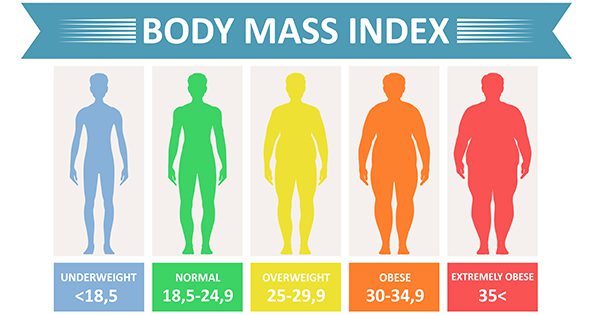Contents
- Formula: woman or man, how to calculate your BMI yourself?
- Interpretation of BMI according to the WHO: what is the ideal weight for my height?
- Below 18,5: your BMI is low
- Between 18,5 and 25: your BMI is normal or within the norm
- Over 25: your BMI is high, you are overweight or some form of obesity
- BMI women and men: what are the French averages?
- Ideal weight: BMI in children, girls and boys
The BMI (Body Mass Index) is a good way to determine your “healthy” weight and anticipate the risks to our health of being overweight, but also of being thin. What is the method to calculate it? How to interpret the result? Who is this tool for? We take stock.
Formula: woman or man, how to calculate your BMI yourself?
The calculation of BMI (Body Mass Index) is based on two simple variables to measure: weight and height. We divide the weight (in kilos), by the height (in m) squared. The figure obtained corresponds to a reference value which makes it possible to estimate the corpulence of a person. This is an international standard, established by the World Health Organization (WHO).
Be careful, a perfect BMI is not synonymous with a perfect body. This tool gives purely theoretical indications, it is therefore necessary to consult a doctorin case of imbalance, which can take stock of your health. BMI calculation remains a reliable method for adults aged 18-65, but does not apply to certain categories of people, including pregnant or breastfeeding women, sick people, or athletes.
What does IMC mean?
BMI is an acronym made up of the initials of the words Body Mass Index. In English, we say BMI for body mass index.
Interpretation of BMI according to the WHO: what is the ideal weight for my height?
The BMI value is classified according to the following interpretations given by the WHO:
- Less than 16: Anorexia or undernutrition
- Between 16.5 and 18.5: Thinness
- Between 18.5 and 25: Normal build
- Between 25 and 30: Overweight
- Between 25 and 30: Moderate obesity (Class 1)
- Between 35 and 40: High obesity (Class 2)
- Between 35 and 40: Morbid or massive obesity
Below 18,5: your BMI is low
A BMI lower than 18,5 indicates that you are in a situation of thinness, even anorexia or undernutrition. It is therefore recommended that you gain weight in order to reach a normal index. However, only one doctor can comment on your state of health and guide you according to his report on the steps to follow.
Between 18,5 and 25: your BMI is normal or within the norm
A BMI between 18,5 and 25 indicates that you have a normal build. It also means that you are less likely to have health problems. However, you must continue to take care of yourself, for example by practicing a sport.
Over 25: your BMI is high, you are overweight or some form of obesity
A BMI over 25 indicates that you are potentially at risk for diseases related to being overweight, such as high blood pressure, diabetes, and cardiovascular problems. Beyond 30, the risks are even greater. After consulting your doctor, it is advisable to lose weight to return to a normal rate.
BMI women and men: what are the French averages?
It may be interesting to situate your index in relation to the entire population of your country. Thus, in France, 3,5% of the population has a BMI below 18,5; 49,2% of the population has a BMI between 18,5 and 24,9 ; 32,3% between 25 and 29,9; 10,7% between 30 and 34,9; 3,1% between 35 and 39,9; and 1,2% greater than 40.
Ideal weight: BMI in children, girls and boys
In children, the BMI reference values vary physiologically with age. Thus, it is not possible to refer, as in adults, to a single reference value of the BMI. From growth charts suitable for children from 0 to 3 years old appear in the health record. These help to assess the growth of the child according to his weight, height and head circumference.
There are also distinct body curves for girls and boys aged 0 to 18, which allow the body mass index to be interpreted through specific values. These curves can also be downloaded from the website of the Ministry of Health or that of the National Institute for Prevention and Education for Health (INPES). They can also be built automatically using Calimco software.
Monitoring children’s BMI remains essential since facilitates the early detection and management of overweight childrenor obese, as well as those at risk of becoming so.










